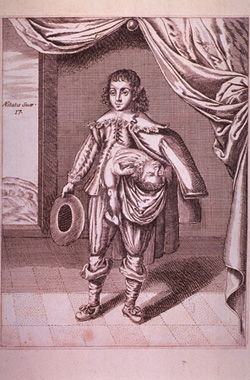 In a small village in India, not far from Mumbai, there is a young man upon whose head sits the malformed head of his own stone-faced twin. If one imagines, say, a woman balancing a jug of water perfectly upright on the top of her skull, this is the basic configuration of the man's gross anatomy?a cranial redundancy with both heads facing forward. "As the patient had grown up," observed physician Ritesh Kansal and his colleagues when the double-headed 20-year-old first stepped into their outpatient facility, "the additional head had [similarly] grown in size."
In a small village in India, not far from Mumbai, there is a young man upon whose head sits the malformed head of his own stone-faced twin. If one imagines, say, a woman balancing a jug of water perfectly upright on the top of her skull, this is the basic configuration of the man's gross anatomy?a cranial redundancy with both heads facing forward. "As the patient had grown up," observed physician Ritesh Kansal and his colleagues when the double-headed 20-year-old first stepped into their outpatient facility, "the additional head had [similarly] grown in size."
I've seen photos, and while the extra head is scarcely human in appearance, it does possess a fully developed nose, mouth, and ears. (Its eyes are closed.) In fact?and I'm loath to admit this, given the rampant superstition already surrounding the case?the second face bears a faint resemblance to a stereotypical smiling Buddha. The young man appears to have gotten the lion's share of the looks in the pair, but given the circumstances, even a handsome face isn't much consolation. Still, as the physicians reported in 2010, he refused to have an MRI to explore surgical removal of the extra head, not because he'd grown attached to it?ahem?or because he was afraid of disrupting the shared vasculature, but rather because of his religious convictions. (Without the benefit of imaging, it's unclear whether this particular extra head held any brain matter, as certain others do.)
Perhaps he's under the impression that God doesn't make mistakes. That may well be true; but if so, and as we're about to see, God has a rather vile sense of humor. What this young Indian man was exhibiting was a remarkable and extremely rare case of craniopagus parasiticus?so rare, in fact, that fewer than a dozen such cases have ever been recorded (the best-known example being Sir Everard Home's two-headed boy of Bengal, whose skull is on display at the Hunterian Museum in London). The unnerving craniopagus is a subtype of a broader developmental disorder known as parasitic, or "heteropagus," twinning (from the Greek heteros meaning "different," and pagus meaning "fixed"). From the perspective of human embryology, parasitic twinning is itself just one of many possible outcomes on the multiple-birth spectrum. Some such happenings produce Ashley and Mary-Kate Olsen*; a few others make for Cheng and Eng; and still fewer create small amorphous bodies that are hidden shamefully under people's shirts for their entire lives.
It's these unsung twins?the disarticulated, malformed, gelatinous or barnacle-like human beings?that are the real marvels of the multiple-birth world. (Actually, as we'll see, while they're certainly human, there's usually not much being to them at all.) Not only do these lesser, rarer couplings serve to highlight how na?ve it is to boil down the world of twins to a simple distinction between fraternal and identical pairs, they also force us to re-examine our most commonsensical assumptions about, say, the "right to life."
Starting with the classical conjoined twins, most embryologists believe there is a natural progression of pathology. In a heteropagus pair, one severely defective individual (the "parasite") is born in an intimate, anatomical embrace with a healthy counterpart (the "autosite"). But believe it or not, it can get much, much worse. Next down the list is the fetus-in-fetu (in which a malformed fetus becomes encapsulated by a normal one, such that the parasite develops inside the autosite's body). Then there are the closely related teratomas (a chaotic, often cancerous, mix of mostly unidentifiable foreign tissues that grow inside the autosite). And the terrible acardiacs?malformed fetuses that come in their own amniotic sacs. Being born without a heart (as their name suggests) is among the least of these latter infants' physical problems. Some unfortunate women have given birth to one healthy twin and an acardiac sibling who consists of only a pair of legs, a head, or a torso.
"Would that these definitions were inviolate!" exclaims physician Rowena Spencer in her review of such cases in the journal Clinical Anatomy. What she's referring to, if somewhat exuberantly, is the fact that mothers may even give birth to multiple forms of these anomalies in a single delivery?a sort of mix-and-match of human nonstarters from a single conception. See, for example, the striking case of a stillborn Czech boy who was found to have 21 ill-formed embryos in his skull, ensconced in a brain teratoma.
Jesse Bering teaches at Wells College and is the author of The Belief Instinct. He is a frequent contributor to Slate and writes the "Bering in Mind" column for scientificamerican.com. His next book will be on the curiously scandalous science of human sexuality. Follow him on Twitter @JesseBering or try adding him on Facebook.Photograph of drawing of boy with parasitic twin from the U.S. National Library of Medicine.
Source: http://feeds.slate.com/click.phdo?i=f430e353e73d9f1341e2082b587dde73
No comments:
Post a Comment
Note: Only a member of this blog may post a comment.